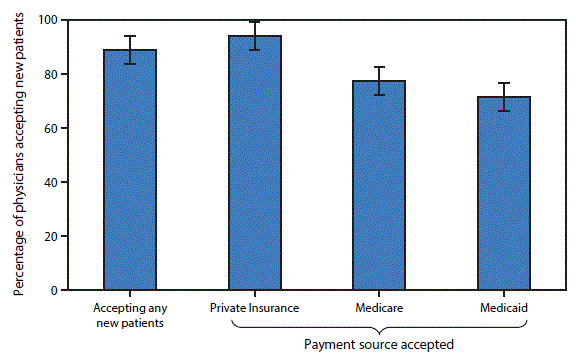QuickStats: Percentage* of Office-Based Primary Care Physicians Accepting New Patients, by Source of Payment Accepted — National Electronic Health Records Survey, 2015
Weekly / July 21, 2017 / 66(28);766

* With 95% confidence intervals indicated with error bars.
Overall, 88.9% of primary care physicians reported that they accepted new patients. However, acceptance varied by the patient’s expected payment source: 94.2% of physicians accepting new patients accepted privately insured patients, 77.4% accepted new Medicare patients, and 71.6% accepted new Medicaid patients. The percentages of primary care physicians accepting new Medicaid or Medicare patients were significantly lower than the percentage of primary care physicians accepting new privately insured patients.
Source: National Electronic Health Records Survey, 2015 data. Data available through the NCHS Research Data Center at https://www.cdc.gov/rdc/index.htm; survey questionnaire available at https://www.cdc.gov/nchs/ahcd/ahcd_questionnaires.htm.
Reported by: Ninee Yang, PhD, nyang1@cdc.gov, 301-458-4689; Esther Hing, MPH.
Suggested citation for this article: QuickStats: Percentage of Office-Based Primary Care Physicians Accepting New Patients, by Source of Payment Accepted — National Electronic Health Records Survey, 2015. MMWR Morb Mortal Wkly Rep 2017;66:766. DOI: http://dx.doi.org/10.15585/mmwr.mm6628a9.
Use of trade names and commercial sources is for identification only and does not imply endorsement by the U.S. Department of
Health and Human Services.
References to non-CDC sites on the Internet are
provided as a service to MMWR readers and do not constitute or imply
endorsement of these organizations or their programs by CDC or the U.S.
Department of Health and Human Services. CDC is not responsible for the content
of pages found at these sites. URL addresses listed in MMWR were current as of
the date of publication.
All HTML versions of MMWR articles are generated from final proofs through an automated process. This conversion might result in character translation or format errors in the HTML version. Users are referred to the electronic PDF version (https://www.cdc.gov/mmwr) and/or the original MMWR paper copy for printable versions of official text, figures, and tables.
Questions or messages regarding errors in formatting should be addressed to mmwrq@cdc.gov.
- Page last reviewed: July 18, 2017
- Page last updated: July 18, 2017
- Content source:


 ShareCompartir
ShareCompartir